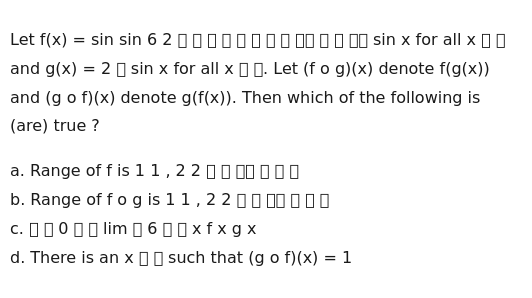Question
Question: Let f(x) = sin sin 6 2 sin x for all x and g(x) = 2 sin x for all x...
Let f(x) = sin sin 6 2 sin x for all x and g(x) = 2 sin x for all x . Let (f o g)(x) denote f(g(x)) and (g o f)(x) denote g(f(x)). Then which of the following is (are) true ?

Range of f is 1 1 , 2 2
Range of f o g is 1 1 , 2 2
0 lim 6 x f x g x
There is an x such that (g o f)(x) = 1
Options (A), (B), and (D) are true.
Solution
Solution:
We are given:
f(x)=sin(6πsin(2πsinx))for all x∈R, g(x)=2πsinxfor all x∈R.(A) Range of f:
For any x, sinx∈[−1,1]. Thus:
-
2πsinx∈[−2π,2π],
-
Then sin(2πsinx)∈[−1,1],
-
So 6πsin(2πsinx)∈[−6π,6π],
-
Finally, taking sine we get
The sine function in this restricted interval is increasing. Hence, the range of f is:
[sin(−6π),sin(6π)]=[−21,21].So, (A) is true.
(B) Range of f∘g:
We have
(f∘g)(x)=f(g(x))=sin(6πsin(2πsin(2πsinx))).Notice that regardless of the actual form of the argument, the definition of f guarantees that its output always lies in the interval [−21,21] (because the inner sine always produces a number in [−1,1]). Thus, the range of f∘g is also
[−21,21].So, (B) is true.
(C) Evaluate x→0limg(x)f(x):
For small x, use the linear approximations:
-
sinx≈x,
-
Thus, sin(2πsinx)≈sin(2πx)≈2πx.
-
Then, 6πsin(2πsinx)≈6π⋅2πx=12π2x,
-
So, f(x)=sin(12π2x)≈12π2x.
Similarly, g(x)=2πsinx≈2πx.
Therefore,
g(x)f(x)≈2πx12π2x=12π2⋅2π1=24π.Thus,
x→0limg(x)f(x)=24π=6π.So, (C) is false.
(D) Existence of x such that (g∘f)(x)=1:
We have
(g∘f)(x)=g(f(x))=2πsin(f(x)).Since f(x) takes all values in [−21,21] and the sine function is continuous and increasing on that interval, sin(f(x)) will vary continuously between
sin(−21)andsin(21).Numerically, sin(21)≈0.4794 and sin(−21)≈−0.4794. Therefore, 2πsin(f(x)) will sweep the interval approximately
[−2π(0.4794),2π(0.4794)]≈[−3.012,3.012].Since 1 lies in this interval, by the Intermediate Value Theorem there exists some x for which
(g∘f)(x)=1.So, (D) is true.
Final Answer: The correct statements are (A), (B), and (D).
